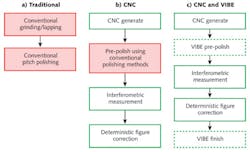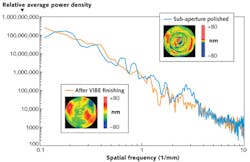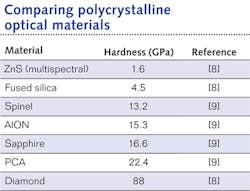OPTICS MANUFACTURING: High frequency and random motion rapidly smoothes optical surfaces
JESSICA DeGROOTE NELSON, ALAN GOULD, CHARLES KLINGER, and MICHAEL MANDINA
In traditional optical polishing, a pitch lap must take on the exact shape of the desired optic (see Fig. 1). If it does not match the exact shape, the high points on the optic will be polished away, causing the optic to become the shape of the polishing lap. The long polishing strokes associated with traditional pitch polishing exaggerate this phenomenon and make it extremely difficult to polish aspheres or nonspherical surfaces using traditional pitch polishing. To meet these manufacturing challenges, Optimax developed the VIBE process—a full-aperture, conformal polishing process designed to incorporate high frequency and random motion to rapidly remove grinding damage in a VIBE pre-polish step and eliminate mid-spatial frequency errors created during deterministic figure correction with a VIBE finishing step.1,2
The VIBE process implements a uniform compliant lap layer that allows for polishing of nonspherical optics. The compliant layer allows polishing of nonuniform local sloped parts, such as aspheres. The VIBE process also introduces short-stroke, high-frequency vibratory motion. Given the compliance in the lap and the short stroke length, the aspheric shape can be maintained without inducing other errors. By altering the level of compliance, the localized slope can be selectively maintained or removed. Compared to conventional pitch polishing and computer-numerical-control (CNC)-based processes, the high-frequency vibration motion creates an environment for accelerated material removal (see Fig. 2).An unconventional VIBE
In traditional optics manufacturing, opticians create lenses or optics by grinding in the desired radius with specialized tooling, followed by pitch polishing that again uses specialized tooling and artisan skill—a time-intensive and iterative process. The creation of an optic becomes more deterministic with the introduction of CNC optics manufacturing technology.3 The CNC generation process replaces the need for specialized grinding tools by creating the desired radius on the optic using diamond ring tools and computer programming. Here, deterministic sub-aperture polishing methods give optics manufacturers the ability to correct known errors. Proprietary software along with a user-defined, interferometrically measured surface with errors and a measured removal function create a dwell map whereby the sub-aperture tool removes more material from the high points than the low points resulting in the desired surface form. The pre-polish step is required after the CNC generation step to remove the damage induced during generation and to create a specular surface that can be measured interferometrically. Using conventional polishing techniques, this pre-polish step can be iterative, time consuming, and extremely difficult for nonspherical surfaces.
A crucial step in the VIBE development process is the compliant layer. VIBE is intended to rapidly remove damage induced during grinding while maintaining the surface shape. This leads to the requirement for a compliant layer that has short-range stiffness and long-range flexibility. Nonuniform, local-sloped parts such as aspheres are polished using VIBE’s short-stroke, high-frequency vibratory motion. Given the compliance in the lap and the short stroke length, the aspheric shape can be maintained without inducing other errors. By altering the level of compliance, the localized slope can be selectively maintained or removed. While a major application of VIBE is polishing aspheric surfaces, process development was performed on spherical surfaces as they can be measured easier using traditional interferometric methods.
The VIBE process has the potential to be introduced in two areas of today’s CNC manufacturing process. The first is to replace the conventional pre-polishing step with the rapid VIBE pre-polish step. Increasing the frequency of the VIBE motion has been shown to increase material removal rates by 10 to 50X over conventional polishing methods (see Fig. 3). High removal rates combined with the compliant lap result in damage-free surfaces that have the same form that was generated by the CNC process for spherical and nonspherical surfaces. The second potential area to incorporate VIBE in the CNC manufacturing process is as a finishing step after deterministic sub-aperture polishing.Removing MSF errors
Novel surface shapes such as aspheres, acylinders, and free-form optics require CNC deterministic sub-aperture polishing techniques. These techniques revolutionized the optics industry with the ability to correct surface low-spatial-frequency form error to a very high accuracy level in a pre-determined amount of time. Deterministic sub-aperture polishing has allowed many optical designers to include nonspherical or higher-accuracy spherical surfaces into their optical systems.
Two of the most common patterns used by deterministic polishing techniques are rotational and raster patterns. These periodic sub-aperture tools leave a residual pattern on the surface of the final optic. Many optical fabrication shops and lens designers often refer to these residual patterns as mid-spatial frequency (MSF) errors or “ripple.” The size and periodicity of these tooling marks, depending on the machine platform by which they were polished, can range from 1–50 mm periods.
Low-spatial-frequency errors are associated with conventional aberrations and blurred features. High-spatial-frequency errors (also referred to as surface roughness) cause wide-angle scatter that reduces the power throughput to the image. And MSF errors contribute to flare or small-angle scattering that reduces the contrast between nearby features. The VIBE process significantly reduces MSF errors by using both the VIBE pre-polishing process, and a VIBE finishing process, which has significantly lower pressure (less than 1 psi) and smaller-sized nanometer-scale abrasive particles (see Fig. 4).4New applications
The material hardness, polycrystalline nature, and nontraditional shape of hard ceramic polycrystalline materials demand creative optical fabrication techniques to cost-effectively produce these types of optics. The hardness values of such polycrystalline materials as spinel, aluminum oxynitride (AlON), and polycrystalline alumina (PCA) would fabricate 8–24X slower than fused silica (see table).
One of the most unique features of the VIBE process is its rapid material removal mechanism. Recently, we conducted a study where the removal rates of PCA were normalized to the conventional polishing rate. For each of four scenarios, the polishing slurry was constant (diamond slurry) as well as the pressure and spindle velocity. The VIBE frequency was held constant for the three VIBE polishing data points. For the VIBE process, the low microtexture pads produce much higher removal rates compared to higher microtexture pads. Further quantification is necessary in order to determine a quantitative optimum level of microtexture for the interface layer.
REFERENCES
1. M.P. Mandina, “Apparatus and process for polishing a substrate,” U.S. patent 6,942,551 B1, Optimax Systems (2005).
2. C. Klinger, “VIBE: A new process for high-speed polishing of optical elements,” Optifab 2007, Rochester, NY, paper TD04-52 (May 14, 2007).
3. H. Pollicove and D. Golini, “Computer Numerically Controlled Fabrication,” SPIE Int.l Trends in Appl. Opt., PM119 (2002).
4. F.W. Preston, J. Soc. Glass Technol., 11, 214–256 (1927).
Jessica DeGroote Nelson is R&D manager and scientist, Alan Gould is R&D engineer, Charles Klinger is R&D engineer, and Michael Mandina is president at Optimax Systems, 6367 Dean Parkway, Ontario, NY 14519; e-mail: [email protected]; www.optimaxsi.com.




